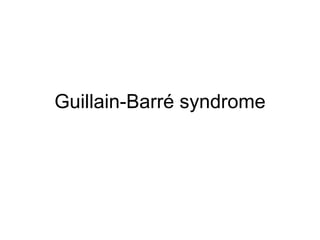Gullianbarrie syndrome
- 2. Causes/ PATHOGENESIS Etiology unknown May be cell-mediated immunological reaction directed at the peripheral nerves Frequently preceded by viral infection, trauma, surgery or other immune system stimulation. Humoral factors and cell-mediated immune phenomena have been implicated in the damage of myelin and/or the myelin-producing Schwann cells T-cell sensitization occurs which causes loss of myelin which disrupts nerve impulses Loss of myelin, edema and inflammation of the affected nerves, causes a loss of neurotransmission to the periphery. 85% of patients recover with supportive care.
- 3. Guillain-BarrÃĐ syndrome has been reported to follow vaccinations epidural anesthesia thrombolytic agents It has been associated with some systemic processes, such as Hodgkin's disease SLE Sarcoidosis, and infection with Campylobacter , Lyme disease, EBV, CMV , HSV, mycoplasma, and recently acquired HIV infection
- 4. CLINICAL FEATURES Two-thirds of patients develop the neurologic symptoms 2-4 weeks after what appears to be a benign respiratory or gastrointestinal infection The initial symptoms are SENSORY CHANGES: paresthesia,numbness; usually mild; 70% pts have sensory abnormalities on edx DYSESTHESIAS: burning,tingling,shocklike,persistent in 5-10% WEAKNESS- ascending and symmetrical, lower limbs involved first, proximal muscles involved earlier; develops acutely and progresses; wide variations in severity; deficits peak by 4 weeks after initial symptoms; recovery begins 2-4 weeks after progression stops
- 5. CLINICAL FEATURES Hypotonia and areflexia (absence of reflexes) More than 90% of patients reach the nadir of their function within two to four weeks, with return of function occurring slowly over weeks to months Involvement of lower brainstem leads to facial and eye weakness RESPIRATORY: 40% patients have respiratory or oropharyngeal weakness AUTONOMIC CHANGES: tachycardia, bradycardia, facial flushing, paroxysmal HTN, orthostatic hypotension, anhidrosis,diaphoresis, urinary retention, ileus, dizziness; more common if severe weakness or respiratory failure
- 6. Ėý
- 7. Variations Miller Fisher Syndrome/Variant (5 % of cases): -ataxia ( mostly in gait and trunk) -opthalmoplegia - areflexia -Motor strength usually spared. -Gradual and near full recovery over weeks to months -Often involves oculomotor, abducens, and trochlear nerves
- 8. Variations-2 AMAN variant -highly associated with C. jejuni infection/DIARRHEA -ascending symmetric paralysis -Edx=pure motor axonopathy -Biopsy shows Wallerian degeneration without much lymphocytic inflammation -Prognosis often very good -Recovery may be rapid but some patients with severe involvement may recover very slowly
- 9. Variations-3 Axonal Form (AMSAN): -usually presents with rapid, severe paralysis -delayed and incomplete recovery -associated with prior C. jejuni diarrhea -pathology shows severe axonal degeneration of motor and sensory nerve fibers with little demyelination
- 10. Variations-4 Pure Sensory Variant -rapid onset of sensory loss and areflexia in widespread and symmetric pattern -LP shows albuminologic dissociation in CSF (elevated CSF protein with normal cell count) -Edx consistent with demyelination -Prognosis usually pretty good
- 11. Variations-5 Acute pandysautonomia without significant motor or sensory involvement- Rare -postural hypotension -bowel and bladder retention -anhidrosis -decreased salivation and lacrimation -abnormal pupillary responses
- 12. Variations-6 Pharyngeal-Cervical-Brachial Variant: -isolated facial, oropharyngeal, cervical, and upper limb weakness
- 13. Physical Examination Symmetric limb weakness with diminished or absent reflexes Ataxia Hypotonia with weakness Minimal loss of sensation despite paresthesias Signs of autonomic dysfunction are present in 50 percent of patients, including Cardiac dysrhythmias (asystole, bradycardia, sinus tachycardia, and atrial/ventricular tachyarrhythmias) Orthostatic hypotension Transient or persistent hypertension Paralytic ileus Bladder dysfunction Abnormal sweating Pupillary dysfunction
- 14. DIAGNOSTIC STUDIES Electrophysiologic studies are the most specific and sensitive tests for diagnosis of the disease They demonstrate a variety of abnormalities indicating evolving multifocal demyelination Slowed nerve conduction velocities Partial motor conduction block Abnormal temporal dispersion Prolonged distal latencies A normal study after several days of symptoms, makes the diagnosis of Guillain-BarrÃĐ syndrome unlikely
- 15. DIAGNOSTIC STUDIES After the first week of symptoms, analysis of the cerebrospinal fluid (CSF) typically reveals normal pressures few cells (typically mononuclear) an elevated protein conc. (greater than 50 mg/dL) Early in the course (less than one week), protein levels may not yet be elevated, but only rarely do they remain persistently normal If CSF pleocytosis is noted, other diseases associated with Guillain-BarrÃĐ syndrome eg, HIV infection, Lyme disease, malignancy, and sarcoidosis should be considered
- 16. TREATMENT The main modalities of therapy for Guillain-BarrÃĐ syndrome include Plasmapheresis and Administration of intravenous immune globulin Ventilator support!
- 17. Plasmapheresis Plasma exchange is recommended for patients who Are unable to walk unaided Demonstrate worsening vital capacities Require mechanical ventilation Have significant bulbar weakness As a result of the cost, risk, and discomfort to the patient, plasma exchange is generally not used for ambulatory patients with mild disease or for patients whose symptoms are no longer progressing after three weeks
- 18. Treatment 40% patients hospitalized will need inpatient rehabilitation, 1/3 need ventilatory support Monitor for hemodynamic instability and arrhythmias Early daily ROM, proper positioning, increasing upright tolerance and endurance, active muscle strengthening, mobility skills
- 19. Energy conservation Work simplification Promotion of safe swallow Alternative communication strategies if needed Cognitive evaluation,esp. if long ICU stay or time on ventilator Adjustment to disability
- 20. Optimize nutrition Monitor for infectious complications (UTI,pneumonia,sepsis) Respiratory therapy-serial eval of ventilatory status Cardiac monitoring Prevent DVT, pressure ulcers,contractures Bowel and bladder function
- 21. Surgical: tracheotomy, percutaneous feeding tubes





















